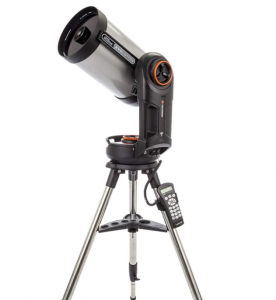
Best Selling Astronomy Telescopes to Explore Universe
Selecting the top 10 best selling astronomy telescopes to explore universe is the first step in exploring the planets and far- off galaxies. The best telescope to see planets and galaxy, deep space exploration, and astrophotography viewing are all reviewed in this guide. We have everything you need, whether you’re looking for a cheap telescope, a good astrophotography telescope, or even the greatest astrophotography telescope for beginners. Learn about the instruments that bring the cosmos closer than ever before, from the greatest telescopes for viewing Saturn’s rings to a basic telescopes to explore universe.
Must-Have Features of the Best Selling Astronomy Telescopes to Explore Universe
- Aperture Size
- Magnification Power
- Optical Quality
- Mount Type
- Portability
- Astrophotography Compatibility
- Price & Value
Top 10 Best Selling Astronomy Telescopes to Explore Universe
1. Gskyer Telescope 70 mm AZ Refractor
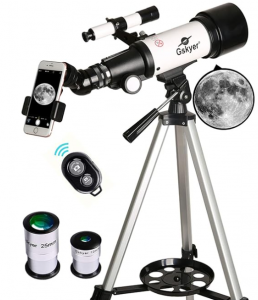
Features-
| Optical Design | Refractor |
| Mount Type | Alt-azimuth |
| Aperture | 70 mm |
| Focal Length | 400 mm |
| Highest Useful Magnification | 120× |
| Lowest Useful Magnification | Approximately 16× (with 25 mm eyepiece) |
| Supplied Eyepieces | 10mm, : Kellner 25 mm and 10 mm; also includes a 3× Barlow lens and erecting diagonal |
2. Celestron StarSense Explorer DX 130 AZ
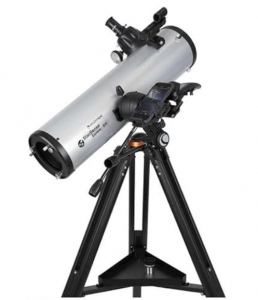
| Optical Design | Newtonian Reflector |
| Mount Type | Manual Alt-Azimuth |
| Aperture | 130 mm (5.11″) |
| Focal Length | 650 mm (f/5) |
| Highest Useful Magnification | 307× |
| Lowest Useful Magnification | 19× |
| Supplied Eyepieces | 25 mm (26×) and 10 mm (65×); includes StarPointer finderscope and StarSense phone dock |
3. Celestron PowerSeeker 127EQ
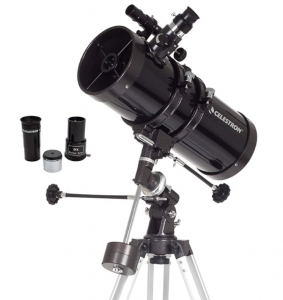
| Optical Design | Newtonian Reflector (Bird-Jones configuration) |
| Mount Type | Manual German Equatorial |
| Aperture | 127 mm (5″) |
| Focal Length | 1000 mm (f/7.9) |
| Highest Useful Magnification | Around 300× |
| Lowest Useful Magnification | Around 18× |
| Supplied Eyepieces | 20 mm (50×) and 4 mm (250×), plus 3× Barlow lens, star pointer finderscope (5×24) |
4. Celestron NexStar Evolution 8
| Optical Design | Schmidt–Cassegrain |
| Mount Type | Motorized Alt-Azimuth (single fork arm) with GoTo tracking |
| Aperture | 203 mm (8″) |
| Focal Length | 2032 mm (f/10) |
| Highest Useful Magnification | Around 480× (according to some sources) |
| Lowest Useful Magnification | Around 29× |
| Supplied Eyepieces | Not specified in specs; typically includes a star diagonal—eyepieces sold separately |
5. Sky-Watcher Dobsonian 10″ (Traditional/Collapsible)
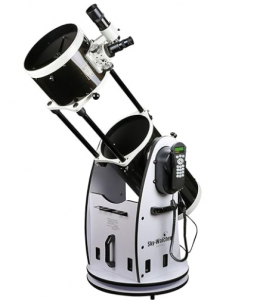
| Optical Design | Newtonian Reflector (Dobsonian) |
| Mount Type | Manual Alt-Azimuth rocker/dobsonian base |
| Aperture | 254 mm (10″) |
| Focal Length | 1200 mm (f/4.7) |
| Highest Useful Magnification | Up to 500× |
| Lowest Useful Magnification | Around 36× |
| Supplied Eyepieces | 25 mm (48×) and 10 mm (120×), plus 9×50 finderscope |
6. Celestron NexStar 6SE
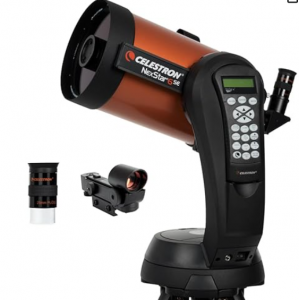
| Optical Design | Schmidt–Cassegrain catadioptric |
| Mount Type | NexStar SE OTA Single Fork Arm Mount |
| Aperture | 150 mm (5.91 inches) |
| Focal Length | 1500 Millimeters |
| Highest Useful Magnification | 354 x |
| Lowest Useful Magnification | 21 |
| Supplied Eyepieces | 25mm eyepiece |
7. Celestron AstroMaster 114EQ
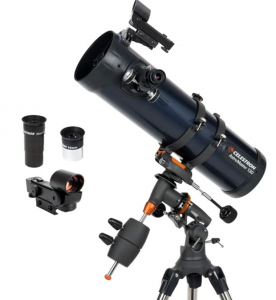
| Optical Design | Newtonian Reflector with a spherical primary mirror (Bird–Jones configuration) |
| Mount Type | Manual German Equatorial (CG-2) with setting circles and dual slow-motion cables |
| Aperture | 114 mm (4.49 in) |
| Focal Length | 1000 mm (39.37 in) — yielding a focal ratio of approximately f/8.77–f/9 |
| Highest Useful Magnification | ~269× |
| Lowest Useful Magnification | ~16× |
| Supplied Eyepieces: | 20 mm erect-image eyepiece with built-in erecting optics (50×) 10 mm standard eyepiece (100×) |
8. Celestron FirstScope 76
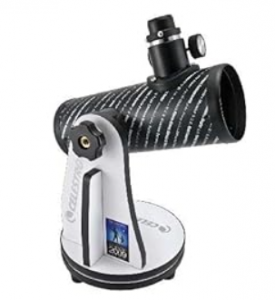
| Optical Design | Newtonian Reflector with a spherical primary mirror (Dobsonian tabletop style) |
| Mount Type | Manual tabletop Dobsonian (alt-azimuth-style) |
| Aperture | 76 mm (2.99 in) |
| Focal Length | 300 mm (11.8–12 in), resulting in a fast focal ratio of f/3.95 |
| Highest Useful Magnification | Approximately 180× |
| Lowest Useful Magnification | Approximately 11× |
| Supplied Eyepieces: | 20 mm (≈15× magnification) 4 mm (≈75× magnification) |
9. Celestron Inspire 80AZ
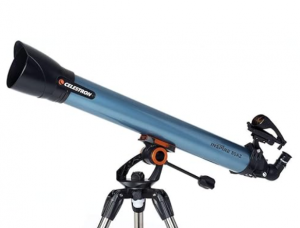
| Optical Design | Refractor telescope |
| Mount Type | Manual Alt-Azimuth with clutch-style panning handle and built-in accessory tray |
| Aperture | 80 mm (3.15 in) |
| Focal Length | 900 mm (35.4 in), resulting in a focal ratio of f/11 |
| Highest Useful Magnification | Approximately 189× |
| Lowest Useful Magnification | Approximately 11× |
| Supplied Eyepieces: | 20 mm Kellner (≈45× magnification) 10 mm Kellner (≈90× magnification) |
10. Unistellar eQuinox 2 (Smart Telescope)
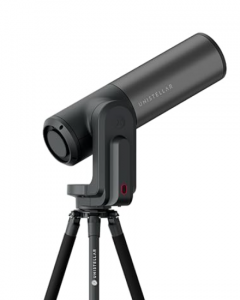
| Optical Design | Newtonian Reflector with digital enhancement (smart telescope) |
| Mount Type | Motorized Alt-Azimuth |
| Aperture | 114 mm (4.5 inches) |
| Focal Length: | 450 mm (f/3.9–f/4) |
| Highest Useful Magnification | up to 228× (optical) and digital up to 400× |
| Lowest Useful Magnification | (not explicitly stated; but the optical magnification starts at 50×) |
| Supplied Eyepieces | Uses integrated Nikon-based micro-OLED electronic eyepiece—no traditional eyepieces included |
Conclusion-
With the correct equipment, the night sky can become even more magnificent, and these ten best telescopes offer the greatest choices for any stargazer. While those looking for the best telescope to view planets and Saturn rings will appreciate models like the AstroMaster 114EQ or Inspire 80AZ, beginners can start with a less expensive telescope like the Celestron FirstScope 76. This list guarantees that there is a high-quality telescope for every degree of astronomy enthusiast, whether you are looking for a telescope to observe planets, take pictures of galaxies, or just find the best telescope for observing planets and galaxies.
Frequently Asked Questions (FAQs) to Buy Best Selling Astronomy Telescopes to Explore Universe
Q1. What is the best astronomy telescope to explore universe clearly?
The best telescope to see planets usually has at least a 90mm aperture and a stable mount. Popular choices include the Celestron NexStar 6SE and AstroMaster 114EQ.
Q2. Which is the best telescope for astrophotography?
For beginners, a refractor with a sturdy mount is the best telescope for astrophotography. Advanced users may prefer computerized telescopes for long exposures.
Q3. Can an affordable telescope still show planets and galaxies?
Yes! An affordable telescope like the Celestron Inspire 80AZ or FirstScope 76 can be a great starting point to see Saturn’s rings, Jupiter’s moons, and bright galaxies.
Q4. What is the difference between a telescope to see planets and one for deep space?
A telescope to see planets works best with higher magnification and longer focal length, while the best telescope for deep space has a larger aperture to gather more light.
Q5. Do I need a professional telescope to explore universe?
Not necessarily. A good quality telescope with at least 4–6 inches of aperture can reveal details like Saturn’s rings and Jupiter’s cloud bands without being fully professional.











